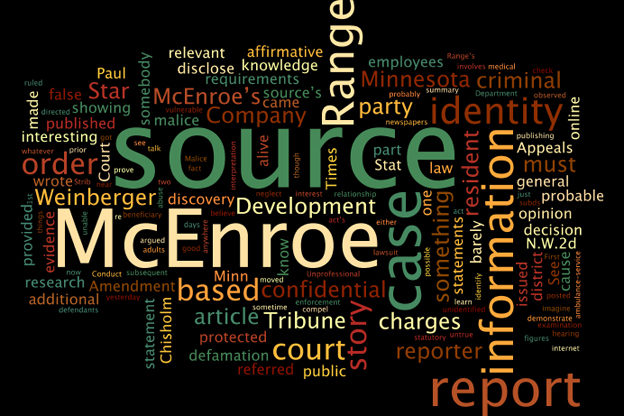

It’s a puzzle
The Minnesota Court of Appeals issued a decision yesterday in the case of Range Development Company of Chisholm v. Star Tribune. (It would be interesting to check sometime to see if the plaintiff here is a beneficiary of the IRRRB’s largess. I imagine it is.) It was of interest to me because it involves newspapers, the First Amendment, and evidence. The case was a review of a district court’s discovery order directed to the Star Tribune and its reporter, Paul McEnroe, now a reporter for KSTP, to disclose the identity of McEnroe’s source for a story about patient neglect in a nursing home. The source provided McEnroe with a Minnesota Department of Health report prior to its public issuance, and upon which McEnroe based his story.
McEnroe says he wrote the story based on the report, some internet research, and his general knowledge; he says he didn’t talk to the source for additional information about the case. This is from the opinion:
Range [Development Company] filed a defamation lawsuit against Star Tribune and McEnroe, Chisholm Ambulance Service and its employees, and McEnroe’s unidentified source. Discovery commenced and focused, in part, on the identity of McEnroe’s source. After deposing McEnroe and several ambulance-service employees, Range was unable to identify the source. McEnroe did provide an affidavit stating that the confidential source had supplied him with a copy of the report a few days before it was posted online, and that he wrote the article based on the report, and not on any other information provided by the confidential source. He acknowledged that he also based the article on his own medical research online and his general knowledge of the working relationship between licensing agencies and law enforcement relating to possible abuse of vulnerable adults.
The Strib defendants also appealed the denial of a motion for summary judgment, which the appeals court denied, too, saying, “What about these statements?” (these were things in the story, but not in the MDH report):
“that the resident was “barely alive,” and that the case was referred for criminal charges”
From the opinion:
Range moved to compel discovery of the source’s identity. It argued that McEnroe’s claim that all his information for the article came from the report was inconsistent with the fact that some of the article’s statements (e.g., that the resident was “barely alive,” and that the case was referred for criminal charges) differed from the report. Range sought to learn where—if anywhere—this additional information came from. It posited that McEnroe “got some other information from somebody else.” After a hearing, the district court issued an order requiring McEnroe to disclose the identity of his source to Range’s counsel. [This is the order that the Court of Appeals reversed.]
Range Development also sued and deposed the first responders as possible sources of the statements in question, as noted above, but they were dismissed from the case. Apparently, no sources here.
The court ruled that the Minnesota shield law protected the Strib and McEnroe from disclosing the source. Here’s just part of what the court said:
After examination of the act and its subsequent interpretation in Bauer, Weinberger and In re Charges of Unprofessional Conduct, we conclude that a party seeking disclosure of a journalist’s confidential source must make an affirmative showing on the statutory requirements. See Minn. Stat. § 595.025; Weinberger, 668 N.W.2d at 673-75. That affirmative showing is called for by the act’s requirements that the party demonstrate that the source’s identity will lead to relevant evidence and establish probable cause to believe that the source has clearly relevant information. See Minn. Stat. § 595.025, subds. 1, 2; Weinberger, 668 N.W.2d at 674 (defining probable cause).
Here’s the interesting question, though: How did reporter Paul McEnroe know that the resident was “near death” and that the case had been forwarded for criminal charges?
There are two ways you can know something. Either you personally observed it, or somebody told it to you (you heard it; you read it; whatever). That’s it. If you don’t have one or the other when you publish a fact, you made it up.
For public figures, which Range Development Company is for our purposes here, in order to win a defamation action, it must be established that the party publishing the statement must have acted with “malice.” (That’s the holding of my favorite 1st Amendment case of all time, the 1964 decision in New York Times v. Sullivan.) Malice means that either you published something knowing it was false, or you published it not caring whether it was true or false.
If the source turns out to be wrong, you are still protected under the Times case if you relied on the source in good faith. But if you don’t have a source, preferably a couple of them, well, that’s a problem. It falls into the category of not caring whether it was true or false.
Social media implied this decision was a journalistic win, but I’m not so sure. When it returns to the district court for a trial, if the statements prove false, the Strib defendants will be scrambling to avoid a finding of malice.
Thanks for your feedback. If we like what you have to say, it may appear in a future post of reader reactions.

